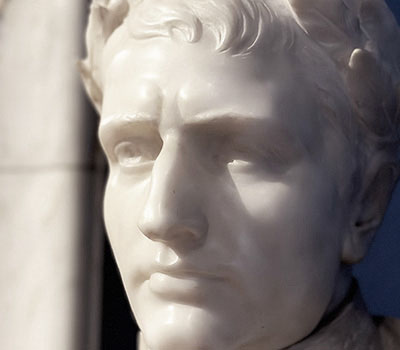Room I-II - Civic historical collections
Room I-II

The Napoleonic period
The Italian Risorgimento began with Napoleon's occupation, which brought with it a political renewal and the spread of ideals of freedom and independence established during the French Revolution. His exploits were also a source of inspiration for many artists who created works with a strong celebratory impact. The exhibition itinerary opens with the Flag of the Lombard Legion of Hunters on Horseback, one of the first tricolors donated to the Italian patriots who voluntarily joined the French army in the war against Austria, adopting the green, white and red on the standard during the Battle of Arcole, 16 November 1796.
The motto "live free or die" and the symbols adopted recall the revolutionary ideals, the fight against absolute power, the demands for freedom and the birth of a national identity. On the front are represented the red Phrygian cap, which in Ancient Rome distinguished freed slaves, while on the back the daggers of Brutus and Cassius, used in the conspiracy to kill Caesar and the archipendulum, an instrument for verifying the balance of a surface, symbol of equality invoked during the French Revolution. The period from 1796 to 1799, which saw the birth of the Cispadane Republic - which later became Cisalpine - was characterized by an intense political life and various innovations in the administrative and legal fields. In 1805 Napoleon became King of Italy: the bust portraying him wearing the Iron Crown and the Laurel Crown, used during the coronation which took place in the Milan Cathedral on 26 May, is evocative.
Comolli's work, an interesting example of the neoclassical style, is placed next to the precious relics of the ceremony - the imperial crown, the royal green velvet mantle with his monogram embroidered on the back, the "hand of justice" and the scepter with the Lion of San Marco. During the Napoleonic reign the government apparatus was modernized and Milan became a city in turmoil, very active culturally and economically. However, the growing climate of despotism exasperated the bourgeois classes, whose expectations of freedom and unification were disregarded, and the popular classes, tired of heavy taxation and military conscription. When Napoleon, defeated by the allied European powers, was forced to abdicate, a revolution broke out in Milan, during which the Minister of Finance of the Kingdom of Italy, Giuseppe Prina, was assassinated. The sequence of events of that famous April 20, 1814 was skillfully represented by the painter Giovanni Migliara.